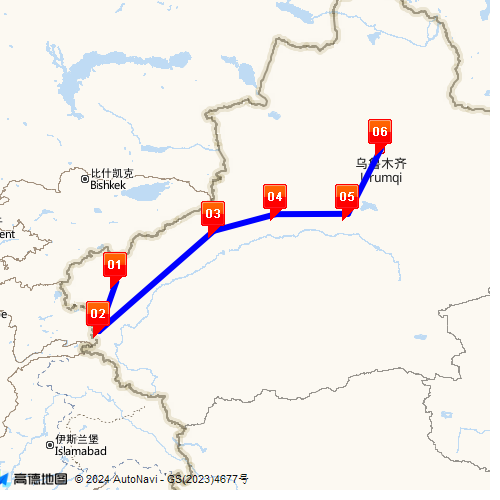Day 1 Kashgar
Day 2 Kashgar
The Id Kah Mosque is reputed to be the largest mosque in China. It highlights a group of old Islamic constructions with strong ethnic style and religious features.
The Fragrant Concubine's Tomb, located in Kashgar, Xinjiang, is a historical site associated with the legendary story of a Uyghur princess. Visitors can explore the tomb and learn about the fascinating tale of love and tragedy behind it. The site offers a glimpse into the rich history and cultural heritage of the region, making it a must-visit for history enthusiasts and those interested in folklore.
Day 3 Kashgar - Tashkorghan (by automobile)
White Sand Lake is near Kashgar, which is a peaceful oasis with clear waters and sandy beaches. Perfect for relaxation and water activities, surrounded by picturesque mountains.
Day 4 Tashkorghan - Shache (by automobile)
Muztagh Ata, located on the Pamir Plateau in Xinjiang, is a magnificent snow-capped peak reaching 7,546 meters high. Ideal for climbing and photography, with rich cultural experiences nearby. Welcome to Muztagh Ata and explore this mysterious and beautiful land.
Xinjiang's Ancient Panlong Road, part of the ancient Silk Road, crosses snowy mountains, grasslands, and deserts in western Xinjiang, offering stunning scenery. Travelers can explore the ancient trade route, experience history, and enjoy Xinjiang's unique culture and natural beauty. It's a journey full of historical and cultural charm.
Xinjiang Tasha Ancient Road is an ancient trade route that connects China with Central Asia. This historic road winds through the majestic mountains, stunning valleys, and picturesque landscapes of Xinjiang. Travelers can embark on a journey along the Tashkurgan Ancient Road to explore its cultural heritage, historical significance, and breathtaking natural beauty. Immerse yourself in the rich history and diverse culture of this remarkable region through this unforgettable travel experience.
The Stone City Ruins, located in Tashkurgan Tajik Autonomous County in southwestern Xinjiang, China, date back to the Jin and Tang dynasties. The ruins include city walls, gates, temples, residential areas, and Qing Dynasty government buildings. The city walls, built with stone blocks or adobe, have a perimeter of 1285 meters and cover an area of 107,000 square meters.
The Golden Grassland near Tashkurgan Tajik Autonomous County in Kashgar, Xinjiang, is a picturesque wetland area with a river, surrounded by mountains and colorful forests. The golden grasslands shimmer in the sunlight, with Mongolian yurts and herdsmen adding to the scenic beauty.
Day 5 Shache - Aksu (by automobile)
Located in Shache County, Kashgar Prefecture, Xinjiang Uygur Autonomous Region, the Heritage Expo Park of Shache is an important site showcasing the local cultural heritage and history. This park features ancient architecture, cultural relics, traditional crafts, and more, allowing visitors to explore the region's long history and unique culture. Visitors can tour ancient buildings, appreciate traditional handicrafts, and learn about local historical legends. The park offers a beautiful environment and pleasant scenery, making it a perfect place for relaxation and immersing oneself in a rich historical atmosphere. A visit to the Heritage Expo Park of Shache promises an educational and culturally enriching travel experience.
Day 6 Aksu - Kuqa (by automobile)
Kuqa Wensu Grand Canyon is located in Kuqa County, Xinjiang Uygur Autonomous Region, and is a charming natural landscape. The Grand Canyon is known for its steep canyon terrain, clear streams, and ancient vegetation. Visitors can hike along the canyon, admire the spectacular rock formations, and diverse vegetation. Here, you can experience the grandeur and magnificence of nature, enjoy the fresh air, and tranquil environment. Kuqa Wensu Grand Canyon is an ideal place for outdoor adventures and a paradise for photography enthusiasts. When you visit, you will experience unique natural scenery and a vibrant travel experience.
Day 7 Kuqa
Subash Buddhist Temple Ruins, also known as Jiasi Daban Monastery, are located 20 kilometers northeast of Kuqa City in Aksu Prefecture, Xinjiang, China. Dating back to the Wei and Jin Dynasties, this site includes a Buddhist pagoda surrounded by temples, caves, halls, and monks' quarters. Well-preserved and split by a river, the ruins are mainly concentrated in the West Temple area.
Day 8 Kuqa - Luntai - Korla (by automobile)
Day 9 Korla - Urumqi (by air)
Day 10 Urumqi
-- Private tour guide
-- Private air-conditioned car or coach
-- Land transfers between airport or train station and hotel
-- First entrance tickets as listed
-- Chinese lunch as listed
-- Centrally located hotels with breakfast
-- Domestic flight ticket with tax as listed
-- Service charge & government taxes
-- International flights with taxes
-- Personal expenses such as laundry, drinks, phone bills, optional activities
-- Tips for guides and drivers
-- China Visa
-- Travel insurance

































































